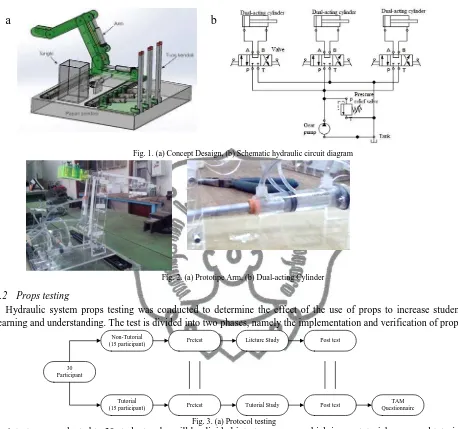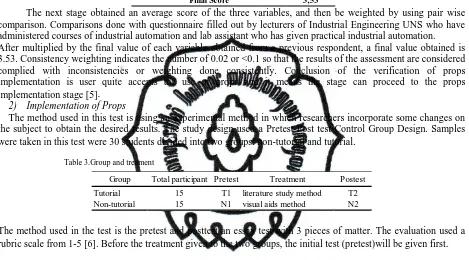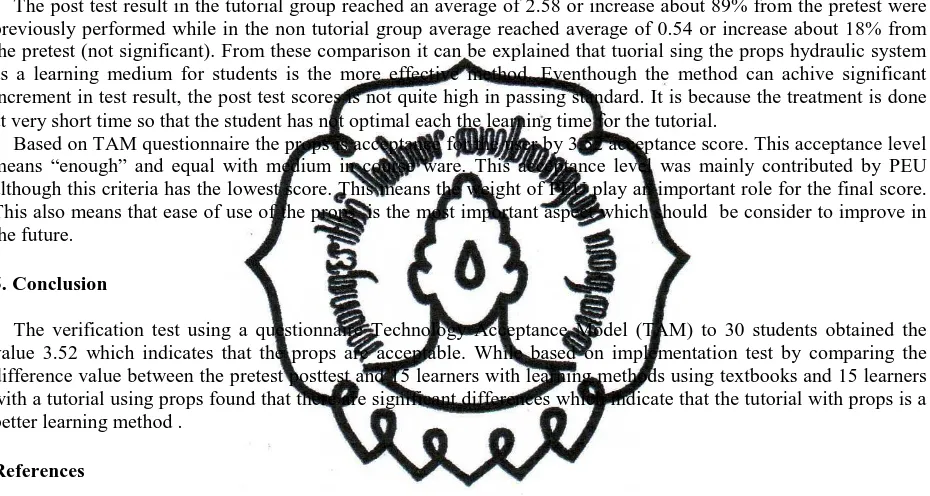commit to user
ScienceDirect
Procedia Manufacturing00 (2015) 000–000
www.elsevier.com/locate/procedia
2nd International Materials, Industrial, and Manufacturing Engineering Conference, MIMEC2015,
4-6 February 2015, Bali Indonesia
Tutorial Props Using Transparent Concept for Improving Student
Competence in Understanding Hydraulic System
P.W. Laksono
a, I. Priyadythama
b, M.H. Azhari
cSebelas Maret Universiy, Jl. Ir. Sutami No. 36A Kentingan, Surakarta (57126)
Abstract
An understanding of the hydraulic system is one of the learning objectives in the manufacturing engineering studies. Generally, knowledge of the hydraulic system its components learned from textbooks. The existence of conventional tutorial props are considered can help the understanding of these materials but this has not enough ability to give a clear ilustrationof how each component in the system is working. This paper aims to look at how far a custom made hydraulic system tutorial props with a transparent flow concept can improve the competence of students in the understanding work of the hydraulic system. The tutorial props of hydraulic system is designed with the theme of material handling, using the robotic 3-arm with a dual-acting cylinder actuator to support the movement of each arm. All components flowed by fluid including valves, hoses, pumps, and actuators are made from transparent material and flowed with visible-colored fluid. The whole system and each component is equipped with a label containing its name and schematic symbol with fluid flow direction. The tutorial props can be operated manually and designed to be easily knock down.Based on verification using the questionnaire of Technology Acceptance Model (TAM) to 30 students obtained a value of 3.52 which indicates that the tutorial props are quite acceptable. While based on implementation test by comparing the difference in value between the pretest and posttest of 15 students using textbooks learning method and 15 students using the tutorial props learning method, found that there are significant differences which indicate that using the tutorial props is a better learning method.
© 2015 The Authors. Published by Elsevier B.V.
Selection and Peer-review under responsibility of the Scientific Committee of MIMEC2015.
KeywordsTutorial props; hydraulic; material handling; TAM (Technolgy Acceptance Model); pretest; post test
1.Introduction
Industrial technology continues to evolve in order to achieve more effective and efficient processes. University as an educational institution which prepare a quality resource for the industry are required to follow these developments. Therefore, in addition to methods of delivering theory in the classroom theory, practicum or tutorial that provides a physical learning experience about the technology is indispensable. Accordance with that, Wankat and Oreovics
2351-9789© 2015 The Authors. Published by Elsevier B.V.
commit to user
(1993) stated told studied that the engineering program without a practicum will be come an applied mathematics program. In other words, theorical education which only provide a conceptual understanding of technology without any technical operational understanding will not be able to provide sufficient knowledge capital to produce professional technical manpower.
An understanding of the hydraulic system is one of the objectives of automation source in manufacturing engineering. In general, knowledge of the components and mechanism of the hydraulic system learned from textbooks. Various methods can be used to improve the understanding of the hydraulic system, one of them is tutorial or practicum which uses a props. According Sudjana (2002), the props are used as a medium of learning so that students are faster and better to understand the subject [1]. The problem is how to make props is easily understood and accepted by learners. According to Dale (1970), the more senses that are used to receive a knowledge, the more and more it is also clear understanding or knowledge will be acquired [2]. In other words, this props is intended to mobilize the senses as much as possible (vision, verbal, audio and movement) to an object so that it could ease the perception.
Previous research has designed a virtual hydraulic props experiment in the form of software. Features courseware such as equipment, assembly procedures, analysis and demonstration either 2D or 3D. But in the courseware there is no physical environtment of hydraulic application as in a real industry.
Therefore, this study aims to see how far a custom made hydraulic props system custom made with a transparent flow concept can improve the competence of learners in understanding the workings of the hydraulic system.
2.Method
The tutorial props of hydraulic system is designed with the theme of material handling using robotic 3-arm with dual acting cylinder actuator to support the movement of each arm.all component which are flowed by fluid, including valves , hoses, pumps and actuator are made from tansparents material and flowed by visible colored fluid. The whole system and each component is equiped with label containing and schematic symbol with fluid flow direction.the tutorial props can be operated manually and designed to be easily knock down.
Two diferent testswere conducted to determine the effect of the use of props to increasing student learning and understanding. The first test carried out questionnaire to 30 random student from indusrial engineering departement of UNS by using TAM (Technology Acceptance Model) to verify whether the user accepts the use of props for learning media. Only relevant criteria would be used in the quetionnaires. The criteria are weighted based on pairwise comparison toward 2 lectures and 4 senior assistent of industrial automation course. This stage would obtain the level of user acceptance rate. Only after the props acceptance verifield the next step was comparing the difference of value between the pretest and post test of two different learning methods, text book and tutorial with props. This tests is conducted toward 30 second year industrial engineering departement students. The students which splited in to two groups for the different methods.
3.Result
3.1 Design Concept
Design concept is to discuss the need of the props and the features needed. From the literature study found that the most effective absorption of learning is through the senses of seeing, give, hear and do [1]. In addition, in designing or selecting props to consider a variety of criteria including learning objectives, effectiveness, learners, availability, technical quality, procurement costs, flexibility, and the ability of people to use the time available [2]. Beside that/in addition, the need was also obtained from the lecturer through some interviews. From the problems that we had/from the problems that exist, it can be concluded that the features needed in props is:
•Component props made transparent
•Props can be assembled
•Props applied to the hydraulic robotic arm system for material handling processes.
•Props using non-toxic material, fire resistance and using low power
.
commit to user
a
b
Fig. 1. (a) Concept Desaign, (b) Schematic hydraulic circuit diagram
Fig. 2. (a) Prototipe Arm, (b) Dual-acting Cylinder
3.2 Props testing
Hydraulic system props testing was conducted to determine the effect of the use of props to increase student learning and understanding. The test is divided into two phases, namely the implementation and verification of props
.
30 Participant
Non-Tutorial (15 participant)
Tutorial (15 participant)
Pretest
Pretest
Liteture Study
Tutorial Study
Post test
Post test TAM Questionnaire
Fig. 3. (a) Protocol testing
A test was conducted to 30 students who will be divided into two groups, which is non-tutorial group and tutorial group. Before the test done we had some pretest in the beginning with same questions for both groups. Pretest here aims to determine the early ability of the students is alike. After that, each groups was given a different treatments. For non tutorial group was given a treatment in the form of study literature, while for tutorial group will do a tutorial of industrial automation with some props. For the next step/phase, both of the groups will be given a same post test questions to determine the differences in the way of increasing knowledge about hydraulic system. Last step/phase, the tutorial group were asked to fill the TAM (Technology Acceptance Model) questionnaires.[4].
1) Verification of Props Implementation
The verification of implementation is the stage where testing is done to determine whether the props used to be accepted by users (learners). Verifying the implementation is performed using the method of Technology Acceptance Model (TAM). This test uses three (3) constructs of TAM research models, namely: Perceived Ease Of Use and Perceived Usefulness (exogenous) and Attitude Toward Using (endogenous variable) [4].
commit to user
Table 2. Final score weighted comparison
The next stage obtained an average score of the three variables, and then be weighted by using pair wise comparison. Comparisons done with questionnaire filled out by lecturers of Industrial Engineering UNS who have administered courses of industrial automation and lab assistant who has given practical industrial automation. After multiplied by the final value of each variable obtained from a previous respondent, a final value obtained is 3.53. Consistency weighting indicates the number of 0.02 or <0.1 so that the results of the assessment are considered complied with inconsistencies or weighting done consistently. Conclusion of the verification of props implementation is user quite accepts the use of props and it means the stage can proceed to the props implementation stage [5]
.
2) Implementation of Props
The method used in this test is using an experimental method in which researchers incorporate some changes on the subject to obtain the desired results. The study design used a Pretest-Post test Control Group Design. Samples were taken in this test were 30 students divided into two groups: non-tutorial and tutorial
.
Table 3.Group and treament
The method used in the test is the pretest and posttest an essay test with 3 pieces of matter. The evaluation used a rubric scale from 1-5 [6]. Before the treatment given to the two groups, the initial test (pretest)will be given first
.
Table 4.Result of the pretest significance
Group Mean tarit hmat ic tt able Criteria
Tutorial 2,89
Non-tutorial 2,93 0,143 1,761 Less significant
Based on the results of the t-test to the data pretest in table 3 the values obtained –ttable = -1,761 ≤ tarithmetic = 0,143 ≤ ttable = 1,761 on α = 5%. From the data above, before the treatments done both groups had a same initial ability. This results can be used as a reference that if there is a differences in the results of the post test is pure from the treatments and not from the different initial conditions.
Table 5. Final result of paired sample t-test
Group Mean N SD Different t P
Non-tutorial 5,47 15 1,451 0,54 -1,934 0,075
Tutorial 3,47 15 0,675 2,58 -5,181 0,000
From the last test of the t-test is known that on tutorial group the average of learning score in the pretest is 2.89 and after the treatments was given in the form of tutorials the score is increased to 5.47, which is in tutorial group the average is reached 2.58 or about 89% from the last pretest score. While known for the non-tutorial groups the average of learning score in the pretest is 2.93 and after the treatments was given in the form of literature study the score is increased to 3.47, which in tutorial group the average is reached 0.54 or about 18% from the pretest score.
No Score Intrepetation
1 1 - 2,33 bad
2 2,34 - 3,67 enought
3 3,68 - 5,00 good
Variabe l weight Score We igt.Score
commit to user
After done a significance test with using SPSS for pretest and post test score for each groups obtained the results in Table 5. From the results of pair test was found that the t score in the non tutorial group is -1.934 with a significant 0.075. Significant score in tutorial group is 0.075 more than 0.05, which means an increasing occurred between pretest and post test is not significant. As for the tutorial group, the score of t-test is -5.181 with a significant 0.000, which means in tutorial group increased significantly between pretest and post test. Then it can be explained that the using of props is effective for study, hydraulic system is more effective used as an instructional media for the students.
4.Analysis
The post test result in the tutorial group reached an average of 2.58 or increase about 89% from the pretest were previously performed while in the non tutorial group average reached average of 0.54 or increase about 18% from the pretest (not significant). From these comparison it can be explained that tuorial sing the props hydraulic system as a learning medium for students is the more effective method. Eventhough the method can achive significant increment in test result, the post test scores is not quite high in passing standard. It is because the treatment is done at very short time so that the student has not optimal each the learning time for the tutorial.
Based on TAM questionnaire the props is acceptance for the user by 3,52 acceptance score. This acceptance level means “enough” and equal with medium in course ware. This acceptance level was mainly contributed by PEU although this criteria has the lowest score. This means the weight of PEU play an important role for the final score. This also means that ease of use of the props is the most important aspect which should be consider to improve in the future.
5.Conclusion
The verification test using a questionnaire Technology Acceptance Model (TAM) to 30 students obtained the value 3.52 which indicates that the props are acceptable. While based on implementation test by comparing the difference value between the pretest posttest and 15 learners with learning methods using textbooks and 15 learners with a tutorial using props found that there are significant differences which indicate that the tutorial with props is a better learning method .
References
[1] Nana Sudjana. 2002. Penilitian Hasil Proses Belajar Mengajar. Bandung: Reamaja Rosdakarya [2] Edgar Dale, Audiovisual Methods in Teaching, (New York: Holt Rinehart and Witson Inc,1969)
[3] Brown, James W, Lewis Robert B, and Harcleroad, Fred F. (1983). AV Instructional: Technology, Media, and Method. New York: Mc. Graw-Hill Book Company.
[4] Davis, F.D, R.P. Bagozzi, and PR. Warshaw. 1989. User Acceptance of Computer Technology: A Comparison of Two Theoretical Models, International Journal Management Machine Studies, August, Vol. 35, No. 8, pp. 982-1003.
[5] Solimun, and Adji Rinaldo. 2009. Pemodelan Persamaan Struktural Pendekatan PLS dan SEM : Aplikasi Struktural Smart PLS dan AMOS 16.0. Badan Penerbit Universitas Brawijaya, Malang


